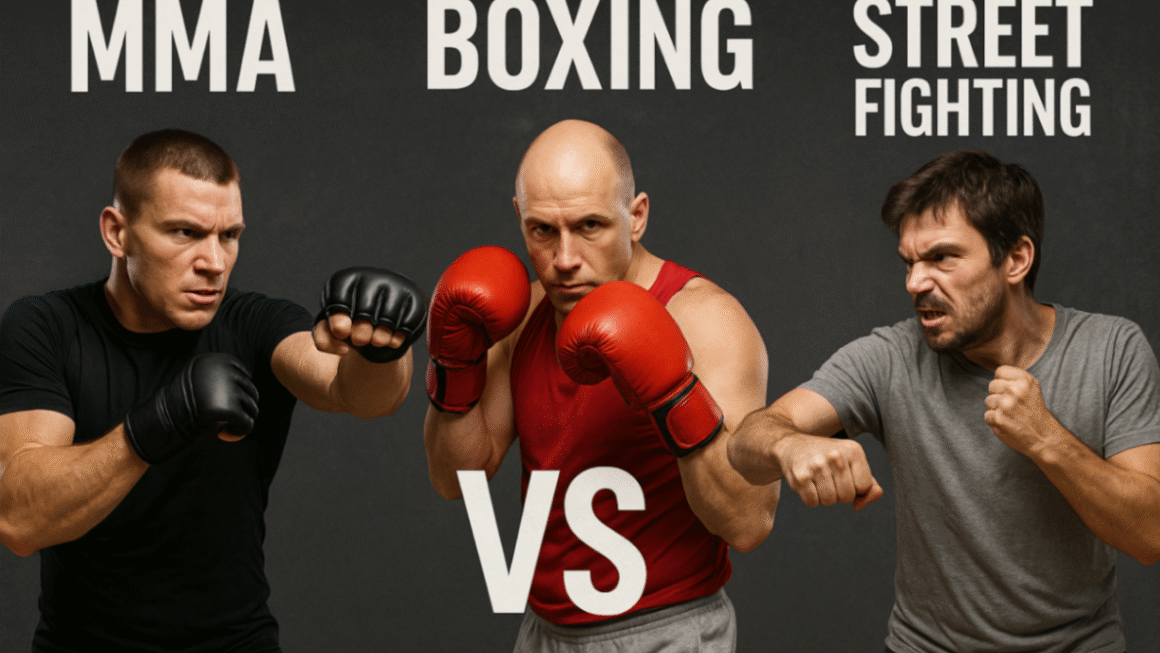Key Highlights
- Underestimating an opponent’s intent or skill is a common and potentially fatal mistake in any confrontation.
- Losing emotional control and acting from rage makes you predictable and vulnerable in a street fight.
- A critical error is ignoring your surroundings and potential environmental hazards that could be used against you.
- Overconfidence, even with martial arts training, often leads to reckless decisions and disastrous outcomes.
- Attempting flashy or complex moves instead of simple, effective defense is one of the most common mistakes.
Introduction
When a confrontation turns physical, the reality of street fighting is vastly different from what you might see in movies or a controlled dojo. The gap between a good fighter and a novice is often defined by the ability to manage natural reactions like panic and adrenaline. Even with martial arts training, anyone can fall victim to common mistakes that have serious consequences. Understanding these errors is the first step toward better self-preservation and learning how to react effectively under extreme stress.
Most Common Mistakes People Make in a Street Fight

There are several street fighting mistakes that can quickly turn a dangerous situation into a disastrous one. Untrained people, in particular, often become prey to their own instincts, leading them to panic, freeze, or act irrationally when faced with real violence. These reactions are natural, but they can be controlled with awareness and preparation.
Recognizing these common mistakes is the first step toward correcting them. Whether it’s a flawed guard, a misjudgment of the opponent, or a loss of composure, each error opens a door for your attacker. In the following sections, we will explore the most critical errors people make in a street fight.
1. Underestimating the Opponent’s Skills or Intentions
One of the most dangerous and common errors is to underestimate the person you are facing. You might assume your attacker is weak, unskilled, or not serious, simply based on their appearance. This assumption can be a fatal mistake, as it creates a false sense of security and leaves you unprepared for the reality of their intentions.
This misjudgment is especially perilous for both trained and untrained fighters. Believing you are superior can cause you to lower your guard or get too close, making you an easy target for a sucker punch or a surprise attack. You have no real idea of the other person’s background, desperation, or what they are capable of.
Always treat any potential attacker as a credible threat. By assuming they are dangerous, you maintain a state of readiness that is essential for self-defense. This mindset prevents you from being caught off guard and allows you to react more effectively if the situation escalates.
2. Losing Emotional Control and Acting Out of Rage
When a street fight begins, the rush of adrenaline can trigger a powerful fight-or-flight response. Giving in to this surge by acting out of pure rage is a critical error. While anger might give you a burst of energy, it completely strips away your ability to think strategically, making your actions violent but extremely predictable.
This loss of emotional control is a significant risk, even for someone with a background in boxing or martial arts. An experienced opponent can easily exploit your rage, using your predictable, wide attacks against you. As noted by one expert, a key difference between a novice and an expert is the ability to manage these reactions. Master Kongling of 6 Dragons Kung Fu states, “While the beginner remains prey to the natural human reactions… The experienced practitioner should be able to exploit their flow (through his/her preparation, concentration and discipline).” [1]
Maintaining your composure is paramount. Emotional control allows you to stay focused, conserve energy, and make rational decisions instead of blindly charging forward. It enables you to defend yourself intelligently rather than becoming a victim of your own emotions.
3. Ignoring Surroundings and Environmental Hazards
Your immediate environment can be your best ally or your worst enemy in a street fighting scenario. A frequent mistake is focusing so intently on the attacker that you lose all awareness of your surroundings. Before the first punch is even thrown, you should be scanning for escape routes, potential weapons, and environmental hazards.
Ignoring these elements can put you at a severe disadvantage. You could be backed into a corner, trip over an obstacle, or slip on an unseen patch of wet ground. Your attacker could also use the environment against you, pushing you into traffic or smashing you against a wall. A lack of an “overall view,” as some experts call it, is a recipe for disaster.
Being mindful of your surroundings is a form of defense in itself. Take a quick mental inventory of the area to identify potential risks and advantages.
|
Potential Hazard |
How It Can Be a Problem |
|---|---|
|
Uneven Ground/Curbs |
Can cause you to trip and fall, leaving you vulnerable. |
|
Walls/Corners |
Limits your movement and creates a trap. |
|
Oncoming Traffic |
Can be used by an attacker to cause serious injury. |
|
Bystanders/Crowds |
Can obstruct your escape or become unintended collateral damage. |
4. Overconfidence Leading to Reckless Decisions
Having experience in boxing or earning a black belt in a martial art can be valuable, but it can also breed a dangerous sense of overconfidence. Believing that your training makes you invincible in a real street fight is one of the most common mistakes that can lead to reckless behavior. This mindset causes you to underestimate threats and take unnecessary risks.
This overconfidence often manifests as a poor or overly relaxed guard. You might feel you don’t need to protect yourself against an “untrained” person, leaving key targets like your head and groin exposed. An ego-driven approach can also lead you to engage in a fight you could have easily avoided, simply to prove a point.
True preparedness involves humility. You must recognize that a street fight has no rules and that your training does not guarantee victory. Approaching every situation with caution, regardless of your skill level, is essential for staying safe and avoiding critical errors born from arrogance.
5. Attempting Fancy Moves Instead of Simple Defense
In the heat of a real conflict, your body will revert to its most ingrained training. One of the classic street fighting mistakes is trying to execute complex or fancy moves you’ve seen in movies or practiced lightly in martial arts class. Under intense stress, the probability of correctly performing a new or complicated technique is incredibly low.
These fancy moves are often impractical for self-defense. They require precise timing, distance, and execution—luxuries you simply do not have in a chaotic street fight. The first thing you should focus on is not offense, but simple, effective defense and creating an opportunity to escape. Attempting a high kick or a complicated throw will likely leave you off-balance and vulnerable.
Instead of trying something flashy, stick to gross motor movements that are reliable under pressure. Your goal is to protect yourself, not to look impressive. Focus on fundamentals like:
- Keeping your hands up to protect your head.
- Maintaining a stable stance and balance.
- Using simple, direct strikes to vulnerable targets if you must.
- Creating distance to disengage and escape.
Conclusion
In conclusion, understanding the biggest mistakes people make in street fights is crucial for ensuring personal safety and effective self-defense. By recognizing the dangers of underestimating an opponent, losing emotional control, and overlooking environmental hazards, you can make better decisions in high-stress situations. Moreover, avoiding overconfidence and focusing on simple, effective defensive techniques rather than flashy moves can significantly increase your chances of successfully navigating a confrontation. Remember, preparation and awareness are your best allies in any street fight scenario. For more tips and insights on self-defense strategies, don’t hesitate to reach out or seek professional guidance.
Frequently Asked Questions
What should you avoid doing if you want to stay safe in a street fight?
To stay safe, avoid underestimating your opponent, losing emotional control, and attempting fancy martial arts moves. Ignoring your surroundings is another fatal mistake. The most important thing to avoid is the street fight itself; escaping should always be your top priority.
Why is not leaving the scene considered a major street fight mistake?
Staying at the scene of a confrontation unnecessarily prolongs your exposure to danger. A good fighter knows that winning means getting away safely. Remaining gives the attacker more opportunities to escalate the violence long after the first punch has been thrown.
How does lack of preparation impact your chances in a street fight?
Lack of preparation makes you a victim of your natural instincts like panic and fear, leading to critical street fighting mistakes. Proper martial arts training helps you manage these reactions, allowing you to think clearly and act effectively instead of freezing under pressure.
Citation:
[1] Kongling, M. (n.d.). The 10 most common combat mistakes. 6 Dragons Kung Fu. Retrieved from https://www.6dragonskungfu.com/the-10-most-common-combat-mistakes/




